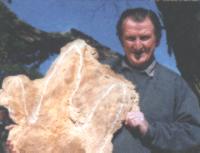Mysterious Australia Homepage
Giant Lizards of the Australian Bush
This disclosure implies that, if these huge monsters were still roaming Queensland's interior a mere 300 years ago, then claimed sightings of these reptiles in modern times in remote areas of Australia suggest Megalania is far from extinct. Needless to say, the find was quickly "hushed up".
After all, it is embarrassing to have a 7 metre or more, several hundred kilogram weight giant monitor lizard species already declared 'extinct' by 'competent' scientists, continuing to survive, when 'expert' opinion dictates it died out with the rest of the Australian megafauna at the close of the last ice-age!
That is the reasoning of the conservative scientific community, who continue to argue that no animal species remain undiscovered, because the entire continent has been completely explored and mapped long ago, making it impossible for any 'unknown species to have escaped detected by science.
This dogmatic view is in error. True, Australia has been explored and mapped from the air; yet there still remain thousands of square kilometres around this continent, consisting of virtually inaccessible mountainous forest country where any 'unknown' or 'extinct' species could easily survive, hidden from modern human detection.
Even our vast interior has been the scene of countless sightings reports for generations of primitive hominid's, and long-claimed 'extinct' species such as the Thylacine, giant marsupial cats, giant snakes, the dinosaur-like Burrunjor of Aboriginal tradition, and Megalania prisca. Thus Australia's "mythical monsters" of the past, continue to defy the dictates of official science that they must remain 'extinct'.
Australia is not alone in traditions of giant lizards. The Komodo Dragon of Indonesia, which is probably an evolved offshoot of Megalania, can reach up to 3 metres in length, while in New Zealand Megalania-sized monsters are a commonplace tradition among the native population. it is claimed that similar lizard monsters still inhabit the Solomon Islands.
The origins of Megalania and its cousins can be traced to the Miocene period, around 25 million years ago. The average skull of a full-grown Megalania was about 80 cm in length {compared to the 5 cm long skull of a living goanna} and housed ferocious teeth. Little wonder it has been named the "ancient giant butcher". This reptillian nightmare preyed upon animal large and small, including stone-age-man.
(Photos: Rex Gilroy)

Author/Cryptozoologist Rex Gilroy with the plaster cast of one of the huge three-toed footprints, of a mysterious bipedal reptillian giant creature, found outside Narooma NSW in June 1984. Such a species is known under a variety of names in ancient Aboriginal traditions Australia wide.
Copyright {c} Rex Gilroy 2001

The plaster cast made by Rex and Heather Gilroy, from a giant monitor lizard footprint, one of a number found by a Moruya NSW farmer in the winter of 1979. Sightings of 3 to 6 metre long giant goanna's continue to be reported from Moruya and other nearby south-coastal NSW districts.
Copyright (c} Rex Gilroy 2001